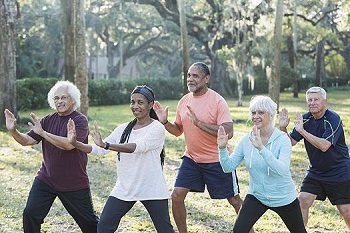10 Things You Might Not Know About Falls
September 3, 2019

September 23, 2019 is the first day of fall—and it’s also National Falls Prevention Awareness Day!
This event presents a great time for seniors to brush up on their knowledge about preventing fall-related injuries. Talking about it and thinking about it are the first steps to lowering the risk. Here are 10 things to know:
- Falls are a serious health problem for our nation’s seniors. According to the Centers for Disease Control and Prevention (CDC), each year three million older adults go to the hospital after a fall. 27,000 of them will die as a result of their fall injuries, and many more will experience disability and loss of independence.
- The risk doesn’t suddenly begin at age 65. Around 10% of people between the ages of 40 – 60 also will experience a serious fall, say experts at the University of Michigan. A recent study from Yale University found that the rate of fall injuries has been rising among the younger baby boomers, especially those who drink too much alcohol or take a lot of medications.
- Not all falls can be prevented—but many can. The first step is to know your personal risk factors. Certain health conditions raise the risk. These include Parkinson’s disease, arthritis, osteoporosis, heart disease, stroke, vision and hearing loss, loss of sensation in the feet due to diabetes, and memory problems. Working with your doctor to manage these conditions is the next step. And did you know that many senior centers, senior living communities and healthcare organizations offer senior fall-prevention classes?
- Fear of falling can actually raise the risk of falls. Here’s how it works: You experience a fall. Fear of falling causes you to cut back on your level of activity. This reduces your muscle tone, energy, reserve of energy, reaction time and alertness…which in turn makes it all the more likely that you will fall. This is a cycle of decline that should be interrupted ASAP!
- Exercise is a top way to fight falls. Ask your doctor for a “prescription” for an exercise program that includes aerobic, strengthening, flexibility and balance activities. Exercise strengthens the body … and also the brain. “When we think about falls, we often think about loss of muscle strength and poor balance,” said Dr. Teresa Liu-Ambrose of the University of British Columbia. “The ability to remain upright and not fall is also dependent on cognitive abilities—calculating how far to lift your foot to get over a curb, making a decision as to when to cross the road, and paying attention to your physical environment while you are having a conversation.”
- We can improve our sense of balance. Some falls are caused by disorders of the vestibular system, located in our inner ear, which is important for our sense of balance. These disorders often can be treated. We can also “build” our balance abilities. Ask your doctor about a balance class, with special exercises and activities such as tai chi that actually improve proprioception—our sense of position.
- Medications can lower our risk of falling … yet they’re also a top risk factor! Prescription and over-the-counter drugs help us control the health conditions that cause falls. But certain drugs, or combinations of drugs, can cause dizziness, confusion, drowsiness and other side effects that affect our alertness and balance. One of the best ways to lower your fall risk is to ask your doctor to review all the medications you take.
- Regular hearing and vision tests are important. Not surprisingly, vision loss is a top risk factor for falls. In some cases, vision can be improved with eyeglasses. Be sure your prescription is up to date, and if you wear bifocals or progressive lenses, ask your doctor if a second pair with single-vision lenses might be safer for walking. Our ears also provide a lot of important information about the environment around us that can help us avoid falling—so if you have hearing aids, use them!
- Staying indoors doesn’t lower the risk. Do you think most falls happen when we’re out and about? Think again! In fact, most falls happen right in a senior’s own home. Lower the risk of falls with home modifications such as low-pile carpeting, improved lighting, handrails on stairs, and grab bars in the bathroom. Remove throw rugs, clutter and other hazards that could cause a stumble.
- It’s important to always watch your step. Be aware of your surroundings as you make your way around your world. So many times, it’s the things we don’t expect that trip us up! Always be thinking a few steps ahead. And one more thing we folks of the 21st century should know: put your smartphone away. Today, many falls are caused by “distracted walking.” Don’t text while you walk—and, say experts, it’s also better to sit down to talk on the phone, as well.
Source: Real Properties in association with IlluminAge Communication Partners; copyright 2019 IlluminAge.
Categories:
Blog Post
![Grace Barker Health [logo]](https://www.gracebarkerhealth.com/wp-content/themes/gracebarker-2017/images/logo.png)




